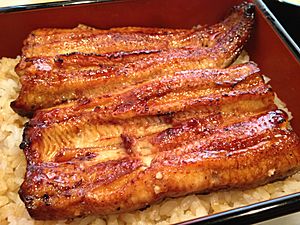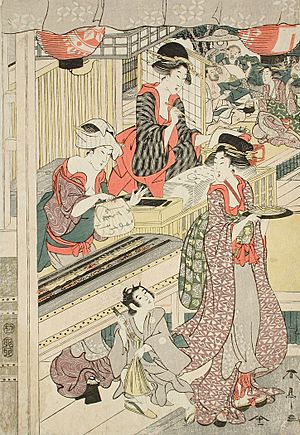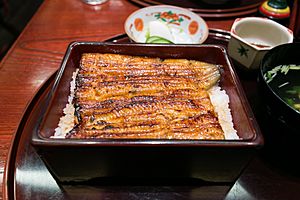Kabayaki facts for kids
Kabayaki is a special way of cooking fish, especially unagi (eel). First, the fish is cut open, cleaned, and its bones are removed. Then, it's flattened, cut into square pieces, and put on skewers. Before cooking, it's dipped in a sweet sauce made from soy sauce. Finally, it's cooked on a grill.
While eel is the most common, other long fish like hamo (pike conger), dojō (loach), catfish, and anago (conger eel) can also be prepared this way. You might even find canned sanma (Pacific saury) cooked in the Kabayaki style.
Kabayaki eel is very popular in Japan. It's also super healthy, packed with vitamins A and E, and good fats called omega-3 fatty acids. There's a fun tradition from the Edo period (a time in Japanese history) to eat Kabayaki in the summer. People believe it helps them stay strong and energetic. This is especially true on a specific mid-summer day called doyō-no ushi-no-hi, which usually falls between July 18 and August 8.
Often, Kabayaki eel is served on top of a bowl of rice. This dish is called unadon. A fancier version, called unajū, comes in a special lacquered box. In the Nagoya area, people sometimes tear up the eel and mix it evenly with rice. This dish is known as hitsumabushi.
Contents
Cooking Styles: East vs. West Japan
There are two main ways to cook Kabayaki in Japan, depending on whether you are in the eastern or western part of the country.
Kantō Style (Eastern Japan)
In the Kantō region, which includes Tokyo, the eel is cut open along its back. This leaves a lighter stripe of its belly skin visible in the middle. The long eel is cut into shorter, squarer pieces and put on skewers.
The Kantō method involves three steps:
- First, the eel is grilled plain, without any sauce. This is called shirayaki.
- Next, it's steamed. This step makes the eel very tender and flaky.
- Finally, it's dipped in the sweet sauce and grilled again until it's perfectly cooked and flavorful.
Kansai Style (Western Japan)
In the Kansai region, which includes cities like Osaka and Kyoto, the eel is cut open along its belly. It's then grilled directly without being steamed first. Often, the eel is cooked in its original long length, which is called nagayaki.
Because the Kansai style doesn't include steaming, the outer skin of the eel can be a bit tougher. To make it softer, people sometimes place the cooked eel between layers of hot rice. The steam from the rice helps to tenderize the eel. In Kansai, eel is sometimes called mamushi, which is also the name of a type of viper snake in Japan. Some people think this name comes from the word mabushi, meaning "to sprinkle," while others think it's because the eel looks like the snake and gives you energy when you eat it.
Where Did the Name Kabayaki Come From?
The name Kabayaki is usually written with Japanese characters that mean "cattail-grilled." Many old writings suggest that the name came from how the cooked eel looked like the brown, fluffy flower spikes of a cattail plant.
One food historian, Tekishū Motoyama, believed that originally, a whole eel was skewered and cooked standing up. This way, it would have looked even more like a cattail plant in both shape and color. This is similar to how the name for kamaboko (a type of fish cake) might have come about too.
Another idea is that the name came from the word kaba-kawa, which means "beech-bark." This is because the charred skin of the eel might have looked like beech bark. Some also think the name comes from kōbashī, which means "fragrant" or "smelling good" when something is toasted or roasted.
See also
 In Spanish: Kabayaki para niños
In Spanish: Kabayaki para niños




